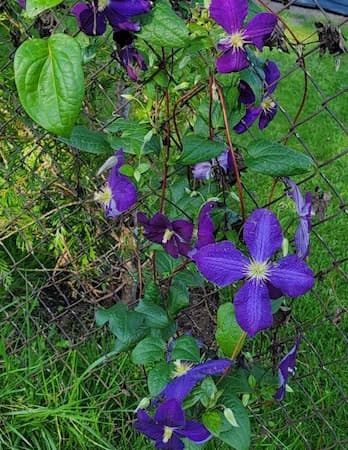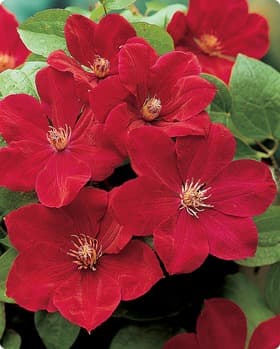How to Grow Clematis Vines

About Growing Clematis Flowers in Your Home Garden
Looking for a climbing vine with big, cheery blooms? Growing Clematis flowers may be your answer. The beautiful flowers are why people love to grow this fast-growing vine. Originating in North America, Asia, and Europe, the perennial Clematis vine can grow up to 10′ or more. With over 300 species, there is a lot of variation in plant habit and blooms. Some varieties have blooms up to 6″ wide. Most Clematis plants bloom once a year. But, there are some re-blooming varieties. This member of the Crowfoot family is perfect for a trellis or fence. Clematis seeds take a few weeks to sprout. You may want to start them indoors.
After the flowers fade, Clematis produces small fruit.
There are over 300 species of Clematis. They are divided into three categories based on when they bloom. They are: spring blooming varieties, varieties that repeat or rebloom, and summer/Fall blooming varieties. If you have space and something for them to climb, why not plant all three types? That way, you will have beautiful Clematis flowers blooming in your yard all season long!
How to Grow Clematis Flowers
Flower Colors: Clematis come in a wide variety of colors. The most common colors include white, red, pink, violet, and blue.
Flowers Bloom: Early Spring to early summer.
Plant Height: Depending upon variety, this plant grows from 4 to 30 feet tall. As a result, make sure to check the plant height when you select the variety you want to grow.
Light Requirements: Full sun.
Ideal Soil pH: 5.5 – 7.0.
Hardiness Zone: 4 – 9.
Toxicity: The plant is toxic to humans, pets, and farm animals.
Native To: Asia, Europe, and North America.
Plant Type: Perennial
Botanical Name: Ranunculaceae
Other Names: Leather Flower
Are Clematis Plants Edible?
NO!!!
Keep children and pets away from this toxic plant. Avoid skin contact. Do not ingest it.
If you suspect your child has ingested any part of the plant, seek medical help immediately. The same applies to you and your pets.
Medicinal Uses for Clematis Plants
Clematis plants have antifungal, anti-inflammatory, antimicrobial, antioxidant, and anti-viral properties. Wow, that’s a lot of “Anti’s”. What this means is the plant has many medicinal uses, despite being a toxic plant. Here are just a few of the things they can be used to treat:
- Gout
- Headaches
- Joint pain
- Skin conditions
- Heal wounds
- Varicose veins
Important Note: Consult your physician before using clematis medically. And, research potential side effects.
Light Requirements
Grow Clematis plants in a location where they will receive full sunlight. They need a minimum of 5 – 6 hours of full sunlight to bloom. In hotter areas of the country, look for a planting site where they will receive light, filtered sunlight in the afternoon.
Perennial Clematis Flower Propagation
Clematis vines are easily propagated by division. The plants do best if divided every two to three years. Simply dig out half to two-thirds of the plants, leaving the remainder in place. Then separate the portion you dug out into two sections and plant in another location or give them to a friend.
Clematis seeds can also be directly seeded into your garden or seeded indoors for transplanting later.
We recommend an indoor start, as Clematis seeds take a long time to germinate.
For outdoor starts, sow Clematis seeds early in the season, and cover lightly with soil. Water thoroughly. Keep the soil moist during the germination period. Make sure to clearly ark the planting site.
Days to Germination: Several weeks or more.

How to Grow Clematis Vines Plants
Clematis likes full sun to light and partial shade. They need 5 – 6 hours of full sunlight for the flower buds to form.
The plants grow best in moist, fertile, and well-drained soil. The roots do not like wet soil for any period of time. Add a generous amount of compost to the planting site.
Space plants 24″-36″ apart. The roots are shallow and should be shaded by growing other flowers around the base of the vine. The use of mulch is not recommended, as Clematis can suffer from wilt and fungus diseases present in decomposing mulch.
The fast-growing vines are heavy feeders. They benefit from ample amounts of fertilizer. Add an all-purpose fertilizer once a month during the growing season.
As a vining plant, Clematis needs something to climb. Growing Clematis on a trellis, fencing, or posts are good options. Train them along the support, as needed.
Clematis will bloom in the spring to early fall. Some varieties bloom twice in a season.
Caution: It is important to know the variety of Clematis vine. Depending upon variety, some blooms emerge from old wood, while others grow from new wood.
How to Prune Clematis Flower Vines
Although you can let Clematis vines grow largely unattended, they will bloom much more profusely when you properly prune them on an annual basis. And, different types of Clematis should be pruned a little differently.
Prune young plants aggressively to about 12 inches. Then, cut the main stem just above a healthy pair of leaf buds. The plant responds by creating more stems which in turn produce more flowers.
For annual pruning of the vines, aggressively trim the vines back. Remove any damaged or diseased leaves and vines. Cut some of the stems way back to increase air circulation. The time of year to prune the vines depends upon the variety you have.
For spring blooming varieties, prune right after the blooming period is over.
For summer and late-blooming varieties, prune them in early spring before the flower buds begin to emerge and swell.
It is also good to deadhead spent blooms right after they have died off. This encourages more blooms to form.
Insects and Plant Disease
Clematis are seldom bothered by insect problems. Use an insecticide only if needed.
On occasion, plant wilt and fungus disease can occur. Use fungicides as needed.
Also see: Plant Problems – causes and cures.
How to Overwinter Clematis Plants
After the first freeze, Clematis flower plants can be cut back for winter. If you do not what variety you have, do not cut the vines back too far. Or, you risk cutting off next year’s blooms.
Then, apply a thick layer of mulch to protect the roots from freezing over the winter months.
Please support our site. Shop for:
- rmmatthews100@hotmail.com
- 585-721-6528
- Rochester, NY
©1999-2024 GardenersNet.Com, All Rights Reserved

